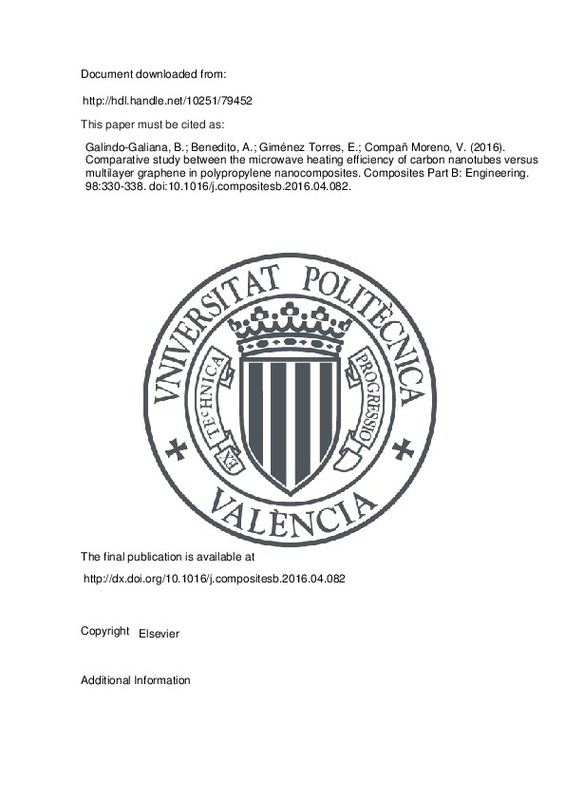JavaScript is disabled for your browser. Some features of this site may not work without it.
Buscar en RiuNet
Listar
Mi cuenta
Estadísticas
Ayuda RiuNet
Admin. UPV
Comparative study between the microwave heating efficiency of carbon nanotubes versus multilayer graphene in polypropylene nanocomposites
Mostrar el registro sencillo del ítem
Ficheros en el ítem
| dc.contributor.author | Galindo-Galiana, Begoña
|
es_ES |
| dc.contributor.author | Benedito, Adolfo
|
es_ES |
| dc.contributor.author | Giménez Torres, Enrique
|
es_ES |
| dc.contributor.author | Compañ Moreno, Vicente
|
es_ES |
| dc.date.accessioned | 2017-04-04T15:54:05Z | |
| dc.date.available | 2017-04-04T15:54:05Z | |
| dc.date.issued | 2016-08-01 | |
| dc.identifier.issn | 1359-8368 | |
| dc.identifier.uri | http://hdl.handle.net/10251/79452 | |
| dc.description.abstract | Multiwall carbon nanotubes (MWCNT) and multilayer graphene (MLG) were studied as microwave susceptor additives for polymers. Different percentages of both nanoparticles were added to polypropylene by melt compounding in order to study the microwave absorption and the polymer heating. Polypropylene was selected as polymer matrix due to its unpolar nature to avoid the influence of polymer polarity and evaluate the influence of the nanoparticles. Electrochemical spectroscopy impedance measurements were carried out to evaluate the conductive and dielectric properties of nano composites. Results showed that nanocomposites with higher electrical conductivity have better capacity of absorbing microwave radiation. High values of permittivity and loss tangent also increases the microwave radiation absorption and the ability of the material to convert this electromagnetic radiation into heat. Carbon nanotubes showed better microwave susceptor behavior than graphene multilayer. Nanocomposites with 1% w/w of carbon nanotubes can be compared with the heating efficiency of a polypropylene filled with 10% w/w of multilayer graphene. The higher efficiency of carbon nanotubes it is explained by their higher electrical conductivity and optimal dielectric properties of the nanocomposites compared to multilayer graphene polymer systems. | es_ES |
| dc.language | Inglés | es_ES |
| dc.publisher | Elsevier | es_ES |
| dc.relation.ispartof | Composites Part B: Engineering | es_ES |
| dc.rights | Reserva de todos los derechos | es_ES |
| dc.subject | Particle -reinforcement | es_ES |
| dc.subject | Electrical properties | es_ES |
| dc.subject | Physical properties | es_ES |
| dc.subject | Thermal properties | es_ES |
| dc.subject | Extrusion | es_ES |
| dc.subject.classification | MAQUINAS Y MOTORES TERMICOS | es_ES |
| dc.subject.classification | FISICA APLICADA | es_ES |
| dc.subject.classification | CIENCIA DE LOS MATERIALES E INGENIERIA METALURGICA | es_ES |
| dc.title | Comparative study between the microwave heating efficiency of carbon nanotubes versus multilayer graphene in polypropylene nanocomposites | es_ES |
| dc.type | Artículo | es_ES |
| dc.identifier.doi | 10.1016/j.compositesb.2016.04.082 | |
| dc.rights.accessRights | Abierto | es_ES |
| dc.contributor.affiliation | Universitat Politècnica de València. Escuela Técnica Superior de Ingenieros Industriales - Escola Tècnica Superior d'Enginyers Industrials | es_ES |
| dc.contributor.affiliation | Universitat Politècnica de València. Departamento de Termodinámica Aplicada - Departament de Termodinàmica Aplicada | es_ES |
| dc.contributor.affiliation | Universitat Politècnica de València. Departamento de Matemática Aplicada - Departament de Matemàtica Aplicada | es_ES |
| dc.description.bibliographicCitation | Galindo-Galiana, B.; Benedito, A.; Giménez Torres, E.; Compañ Moreno, V. (2016). Comparative study between the microwave heating efficiency of carbon nanotubes versus multilayer graphene in polypropylene nanocomposites. Composites Part B: Engineering. 98:330-338. doi:10.1016/j.compositesb.2016.04.082 | es_ES |
| dc.description.accrualMethod | S | es_ES |
| dc.relation.publisherversion | http://dx.doi.org/10.1016/j.compositesb.2016.04.082 | es_ES |
| dc.description.upvformatpinicio | 330 | es_ES |
| dc.description.upvformatpfin | 338 | es_ES |
| dc.type.version | info:eu-repo/semantics/publishedVersion | es_ES |
| dc.description.volume | 98 | es_ES |
| dc.relation.senia | 324227 | es_ES |
| dc.identifier.eissn | 1879-1069 |







![[Cerrado]](/themes/UPV/images/candado.png)

